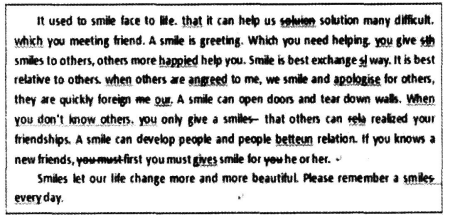手机用户可扫描以下二维码,下载233网校APP,进入教师资格考试题库页面,进行教师资格证考试模拟题、章节题、真题等练习!

2016年下半年中小学教师资格考试
英语学科知识与教学能力试题(高级中学)
注意事项:
1.考试时间为120分钟,满分150分。
2.请按规定在答题卡上填涂、作答。在试卷上作答无效,不予评分。
一、单项选择题(本大题共30小题,每小题2分,共60分)
在每小题列出的四个备选项中选择一个最佳答案。请用28铅笔把答题卡上对应题目的答案字母按要求涂黑.错选、多选或未选均无分。
1. The Chinese recipes rapidly found __________ with foreign restaurant owners.
A. favor
B. flavor
C. fever
D. fancy
2. There is every sign that new Asian immigrants are willing to __________ with Americans.
A. oblige
B. absorb
C. assimilate
D. stabilize
3. In the United States, a(n) __________general is the chief lawyer in a government or city department.
A. senator
B. solicitor
C. councilor
D. inspector
4. All the flights __________ because of the hurricane, they decided to take the train instead.
A. had been canceled
B. having canceled
C. have been canceled
D. having been canceled
5. Which of the following shows how the fraction "7/9" reads in English?
A. Seventh-nine.
B. Sevenths-nine.
C. Seven-ninth.
D. Seven-ninths.
6.__________ man can aspire to and achieve goodness is evident throughout history.
A. What
B. Whether
C. That
D. How
7. The pair of English phonemes __________ differs in the manner of articulation.
A. /k/ and /t/
B. /d/ and /g/
C. /s/ and /z/
D. /t/ and /s/
8. Which of the following shows the proper rhythmic pattern of the sentence?
A. This is a 'question for 'Doctor 'Carrington.
B. This is 'a 'question for 'Doctor Carrington.
C. This is a 'question 'for Doctor 'Carrington.
D. This 'is a 'question for 'Doctor 'Carrington.
9. The pair“__________ ” are dialectal synonyms in British and American English.
A. tap and faucet
B. stroll and trot
C. liberty and freedom
D. statesman and politician
10. Which of the following might be Jane's primary concern when she sincerely asks her friend"Does your farm contain 500 acres"?
A. Quantity maxim.
B. Quality maxim.
C. Relation maxim.
D. Manner maxim.
11. Which of the following assumptions fails to describe the nature of vocabulary or vocabulary learning?
A. Words are best learned in context.
B. A lexical item can be more than one word.
C. All words in one language have equivalents in another.
D. Leaming a word includes learning its form, meaning and use.
12. When a teacher creates a real life situation for his students to discuss, he expects them not to focus on __________ too much.
A. form
B. use
C. meaning
D. function
13. It is suggested that teachers should not interrupt students for error correction when the activ-ity aims at __________ .
A. accuracy
B. fluency
C. complexity
D. cohesion
14. When asking students to quickly run their eyes over a whole text to get the gist, we are training their skill of__________ .
A. scanning
B. mapping
C. predicting
D. skimming
15. Teachers who adopt the __________ model for reading comprehension may start teaching a text by introducing new vocabulary and structures.
A. parallel
B. serial
C. top-down
D. bottom-up
16. It is suggested that lower-level EFLlearners learn to read by reading __________ materials.
A. simple and authentic
B. academic and authentic
C. original and classical
D. classical and authentic
17.When asking students to arrange the scrambled sentences into a logical paragraph,the teacher is focusing on__________ .
A.reading skills
B.critical think
C.proofreading skills
D.textual coherence
18.Which of the following is a typical feature of formal writing?
A.Archaic words are usually preferred.
B.The precision of language is a priority.
C.Short and incomplete sentences are preferred.
D.An intimate relationship with the audience iS established.
19.Which ofthe following writing activities may be used to develop students’skill of planning?
A. Editing their writing in groups.
B. Self-checking punctuations in their writing.
C. Sorting out ideas and putting them in order.
D. Cross-checking the language in their writing.
20. In trying to get across a message, an EFL learner may use __________ strategies to make up for a lack of knowledge of grammar or vocabulary.
A. communicative
B. cognitive
C. resourcing
D. affective
请阅读Passage l,完成第21-25小题。
Passage 1
Einstein is a mental Hercules, according to those who know his work. He has performed prodi-gious labors. By all the theories of physiognomy, he should be a granite-visaged Norse god of the Hindenburg type, instead of looking like a poet or musician. On theoretical grounds, he should have an iron will, instead of being pliant, docile, compromising. The explanation seems to be that Ein-stein, unlike most men of achievement, has never had to coerce or harden himself. His work was an exalted revel and his whole scientific life was a perpetual carnival, to judge from a speech of his at a dinner in Berlin in honor of the physicist, Max Planck. A preceding speaker had talked of the "ago-nizing toil" and "superhuman will" required of a great scientist. Einstein demurred. "This daily striving," he said, "is dictated by no principle or program, but arises from immediate personal need.
The emotional condition which renders possible such achievements is like that of the religious devo-tee or the lover." On another occasion, Einstein described the impulse to grapple with his problems as "a demoniac possession," needing no stimulation from conscious effort of the will. Einstein's own theory about himself must be correct; nothing else could account for his irresistible energy in his own regions of thought and his lamblike helplessness in ordinary contacts. To catalogue a few of his lost wars of everyday life:
For a time he refused to play the violin for charity because of his modest estimate of his own a-bility, and because he thought it unfair to professionals; under pressure, however, he gave many recitals. He declined a deluxe cabin on a trip to America because of his scruples against luxury, but accepted when informed that he was hurting the feelings of the steamship line. On his trip to India,he refused to travel in a rickshaw because he thought it degrading to use a human being as a draught animal; he reconsidered, however, on the ground that rickshaw boys must live, and patronized them extensively. Hating fuss and feathers, he has been induced to make triumphal progresses on four continents. He has compared mass newspaper interviews to being bitten by wolves and to being hanged, but nevertheless he is frequently gang-interviewed.
This easy yielding to pressure would lead another man to cheapen himself, but Einstein is saved by his aesthetic sense and his unworldliness. He could not do anything sordid. He doesn't want any-thing; there is nothing about the man for temptation to work on. When he received the Nobel Prize in 1921, he gave it to charity. When a magazine offered him an amazing sum for an article, he reject-ed it contemptuously. "What?" he exclaimed. "Do they think I am a prizefighter?" But he finally wrote the article after arguing the magazine into cutting the price in half. It is said that he declined his present post at the Institute for Advanced Study at Princeton on the ground that the salary was preposterously munificent, and was persuaded to accept only by the promise of an enormous pay cut.
He objected to gifts, but his 1930 trip to this country netted him five violins and other valuable booty. His backbone stiffened, however, when an admirer sought to press on him a Guarnerius val-ued at $33,000; this he firmly refused, saying that he was not enough of a musician to do justice to the instrument. Probably no man has been more plagued than Einstein by offers of money for testi-monials for toothpaste, pimple-eradicators, corn plasters, and cigarettes. He brushed all this aside as "corruption" and would have no compromise. Einstein regards money as something to give away; in1927, he was aiding one hundred and fifty poor families in Berlin.
21. What has led to Einstein' s great achievement in science according to the passage?
A. His strong belief in religion.
B. His lifelong interest in science.
C. His aesthetic sense and unworldliness.
D. His superhuman will in science research.
22. What does the underlined phrase "his problems" in PARAGRAPH ONE refer to?
A. His scientific pursuit.
B. His daily striving.
C. His superhuman will.
D. His irresistible energy.
23. Which of the following best describes Einstein as a man yielding to pressure?
A. He rejected luxury offers.
B. He often cheapened himself.
C. He usually fell into a dilemma.
D. He didn't accept expensive gifts.
24. Which of the following is the closest in meaning to the underlined phrase "fuss and feath-ers" in PARAGRAPH TWO?
A. Erratic action.
B. Boring routines.
C. Nervous behavior.
D. Pretentious display.
25. Why did Einstein refuse to accept a Guarnerius?
A. He considered it too expensive.
B. He hated all kind of corruption.
C. He didn' t think he was a musician.
D. He felt he couldn' t make the best of it.
请阅读Passage 2,完成第26-30小题。
Passage 2
If you want something done, the saying goes, give it to a busy person. It is an odd way to guarantee hitting deadlines. But a paper recently published in the Journal of Consumer Research suggests it may, in fact, be true--as long as the busy person conceptualises the deadline in the right way.
Yanping Tu of the University of Chicago and Dilip Soman of the University of Toronto exam-ined how individuals go about both thinking about and completing tasks. Previous studies have shown that such activity progresses through four distinct phases: pre-decision, post-decision (but pre-action), action and review. It is thought that what motivates the shift from the decision-making stages to the doing-something stage is a change in mindset.
Human beings are a deliberative sort, weighing the pros and cons of future actions and remain-ing open to other ideas and influences. However, once a decision is taken, the mind becomes more"implemental" and focuses on the task at hand. "The mindset towards 'where can I get a sand-wich' ," explains Ms Tu, "is more implemental than the mindset towards ' should I get a sandwich or not?'"
Ms Tu and Dr Soman advise in their paper that "the key step in getting things done is to get started." But what drives that? They believe the key that unlocks the implemental mode lies in how people categorise time. They suggest that tasks are more likely to be viewed with an implemental mindset if an imposed deadline is cognitively linked to "now"--a so-called like-the-present scenari-o. That might be a future date within the same month or calendar year, or pegged to an event with a familiar spot in the mind' s timeline (being given a task at Christmas, say, with a deadline of Easter).
Conversely, they suggest, a deadline placed outside such mental constructs (being "unlike-the-pre-sent") exists merely as a circle on a calendar, and as such is more likely to be considered delibera-tively and then ignored until the last minute.
To flesh out this idea, the pair carried out five sets of tests, with volunteers ranging from farm-ers in India to undergraduate students in Toronto. In one test, the farmers were offered a financial in-centive to open a bank account and make a deposit within six months. The researchers predicted those approached in June would consider a deadline before December 31st as like-the-present.
Those approached in July, by contrast, received a deadline into the next year, and were expected to think of their deadline as unlike-the-present. The distinction worked. Those with a deadline in the same year were nearly four times more likely to open the account immediately as those for whom the deadline lay in the following year. Arbitrary though calendars may be in parsing up the continuous flow of time, humans parse their concept of time in line with them.
The effect can manifest itself in even subtler ways. In another set of experiments, undergraduate students were given a calendar on a Wednesday and were asked to suggest an appropriate day to car-ry out certain tasks before the following Sunday. The trick was that some were given a caleMar with all of the weekdays coloured purple, with weekends in beige (making a visual distinction between a Wednesday and the following Sunday). Others were given a calendar in which every other week,Monday to Sunday, was a solid colour (meaning that a Wednesday and the following Sunday were thus in the same week, and in the same colour). Even this minor visual cue affected how like-or unlike-the-present the respondents tended to view task priorities.
These and other bits of framing and trickery in the research support the same thesis: that mak-ing people link a future event to today triggers an implemental response, regardless of how far in the future the deadline actually lies. If the journey of 1,000 miles starts with a single step, the authors might suggest that you take that step before this time next week.
26. Why can a busy person hit deadline to the present according to the passage?
A. He cherishes time more.
B. He is good at making decisions.
C. He is used to doing things immediately.
D. He tends to link a future deadline to the present.
27. Which is the closest to the meaning of the underlined phrase "flash out" in PARAGRAPH FIVE?
A. Put forward.
B. Dream up.
C. Add details to.
D. Come up with.
28. What does the underlined "them" in PARAGRAPH FIVE refer to?
A. Mindsets.
B. Calendars.
C. Deadlines.
D. Decisions.
29. What is the author' s primary purpose in writing this passage?
A. Illustrating the key point in meeting a deadline.
B. Contrasting Yanping Tu' s experiment with Dilip Somans.
C. Manifesting how visual cues affect people' s perception of deadline.
D. Comparing a like-the-present deadline with an unlike-the-present one.
30. Which best describes the author' s tone?
A. Humanistic.
B. Objective.
C. Speculative.
D. Recriminatory.
二、简答题(本大题1小题,20分)
根据题目要求完成下列任务。用中文作答。
31.简要说明“多样化(vailetv)原则”在教学设计和课堂教学中的体现(10分),并简述实施多样化教学需要考虑的因素(10分)。
三、教学情境分析题(本大题1小题,30分)
根据题目要求完成下列任务,用中文作答。
32.下面是某高三学生的一篇书面表达。
请结合生活中的一个事例,用英语写一篇短文,谈谈微笑的作用。

根据上面所给的信息.从下列三个方面作答:
(1)该学生的书面表达存在哪三个主要问题?(12分)
(2)反映了该生英语学习中的哪些不足?(12分)
(3)教师应该从哪些方面帮助学生提高写作能力?(6分)
四、教学设计题(本大题1小题,40分)
根据提供的信息和语言素材设计教学方案,用英文作答。
33.设计任务:请阅读下面学生信息和语言素材,设计20分钟的英语读写教学方案。该方
案没有固定格式.但须包含下列要点:
· teaching objectives
· teaching contents
· key and difficult points
· major steps and time allocation
· activities and justifications
教学时间:20分钟
学生概况:某城镇普通高中一年级(第一学期)学生,班级人数40人,多数学生已经达到
《普通高中英语课程标准(实验)》五级水平。学生课堂参与积极性一般。
语言素材:
In some countries in western Europe, such as France, Spain and Britain, the countryside is changing.
Life has become difficult for many villages, and some are disappearing. There are a number of reasons for this. Firstly, young people from villages usually want to live somewhere livelier and they often move to the towns and do not return. Secondly, people move to the cities to find work, as there are very few jobs in the countryside. Some villages still remain because people from the cities have bought a "second home" in the village, where they come and stay at weekends. The price of the homes goes up and people from the area cannot afford to buy a house there. Another problem is that it is becoming more and more difficult for farmers to make money from their farms. So they sell their land and find another job.
All these things mean that many villages in western Europe are fighting to survive. We can only hope that they will remain. The countryside would be a sadder and uglier place without them.
热点推荐:历年教师资格证考试英语学科知识与教学能力真题及答案
通关必看:教师资格证考试备考有妙招,233网校讲师助你快速突破考试重难点,直击90%核心考点,点击查看>>


